Cronyism:
It is the practice of partiality in awarding jobs and other advantages to friends or trusted colleagues, especially in politics and between politicians and supportive organizations.
Dutch Disease:
It is an economic term for negative consequences. It is primarily associated with the new discovery or exploitation of a valuable natural resource and the unexpected repercussions that such a discovery can have on the overall economy of a nation.
The Economic Survey 2020 on pro-crony policies
The Economic Survey 2020 noted that despite impressive progress in enabling competitive markets, pro-crony has destroyed value in the economy. It also pointed out that in order to become a $5 trillion economy, India must wean away from pro-crony policies.
Pro-crony policies, in contrast to pro business ones, erode wealth in the economy as cronyism fosters inefficiencies by ‘inhibiting the process of creative destruction’. These policies may promote narrow business interests and hurt social welfare.
Pro-Business, Creative Destruction and Wealth Creation
The liberalization of the Indian economy in 1991 enabled the forces of creative destruction, generating benefits.
- Post liberalization, there was an increase in market dynamism in the pro-business India of the post-liberalization period.
- After the market reforms of 1991, the Sensex has not only grown but has grown at an accelerating pace.
- It took over 13 years to cross 5000 points which were achieved in 1999. The time taken to achieve each incremental milestone has substantially reduced over the years.
Composition of the Sensex and its evolution:
In the initial years of Sensex (during its inception), there was a lack of dynamism in the index that could be proved by looking at the firms that constituted the index. However, the years following 1991 liberalization saw the rapid emergence of new firms, new ideas, new technologies and new operating processes, causing a steep revision of the Sensex in 1996.
After 1996, the Sensex underwent more frequent revisions, owing to the more dynamic nature of a substantially more competitive Indian market.
Figure shows the number of firms that exited (moved out) the Sensex in each five-year period following 1986:
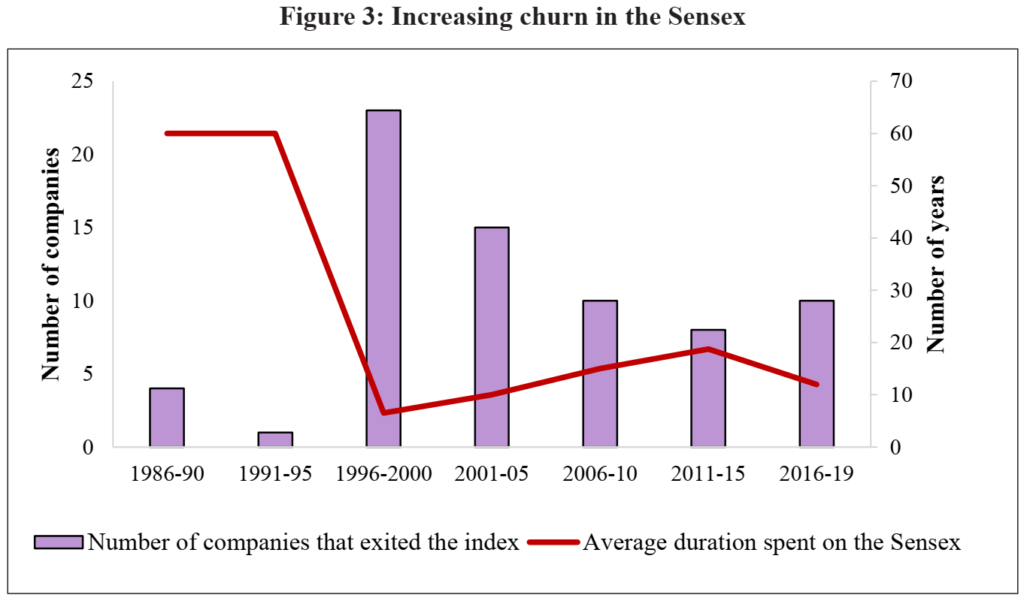
Pro-business policy, i.e., liberalization caused a spike in the number of firms churned in the years that immediately followed it, but the churn rate did not decline to pre liberalization levels in later years.
The figure also indicates the average duration a Sensex constituent remains on the index. Following the 1991 reforms, the average duration a firm spent on the index declined drastically. Currently, a firm is expected to remain on the index for only 12 years – one-fifth of the expected duration prior to the reforms.
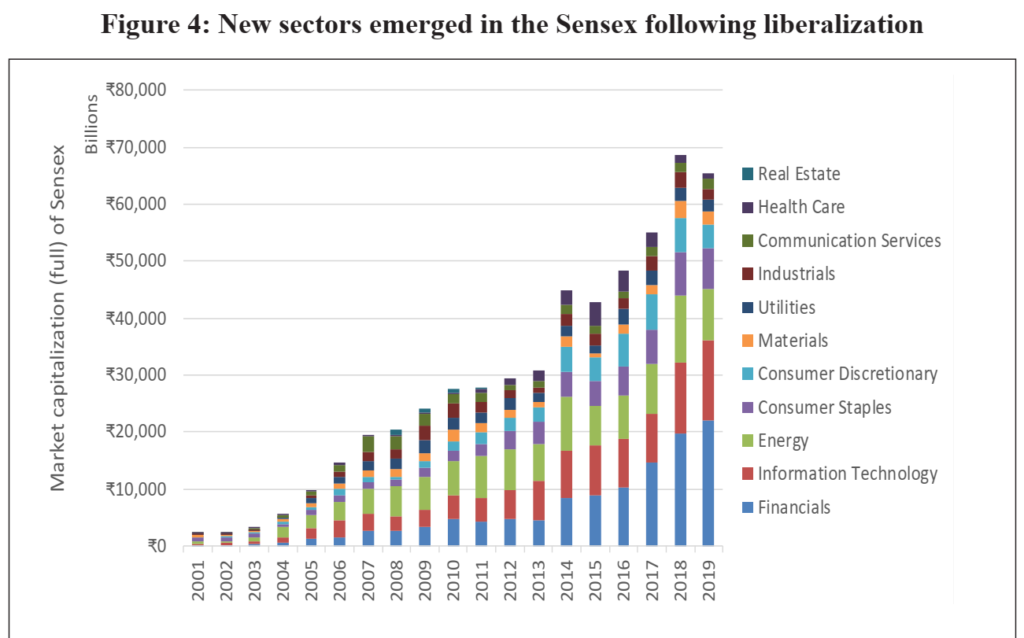
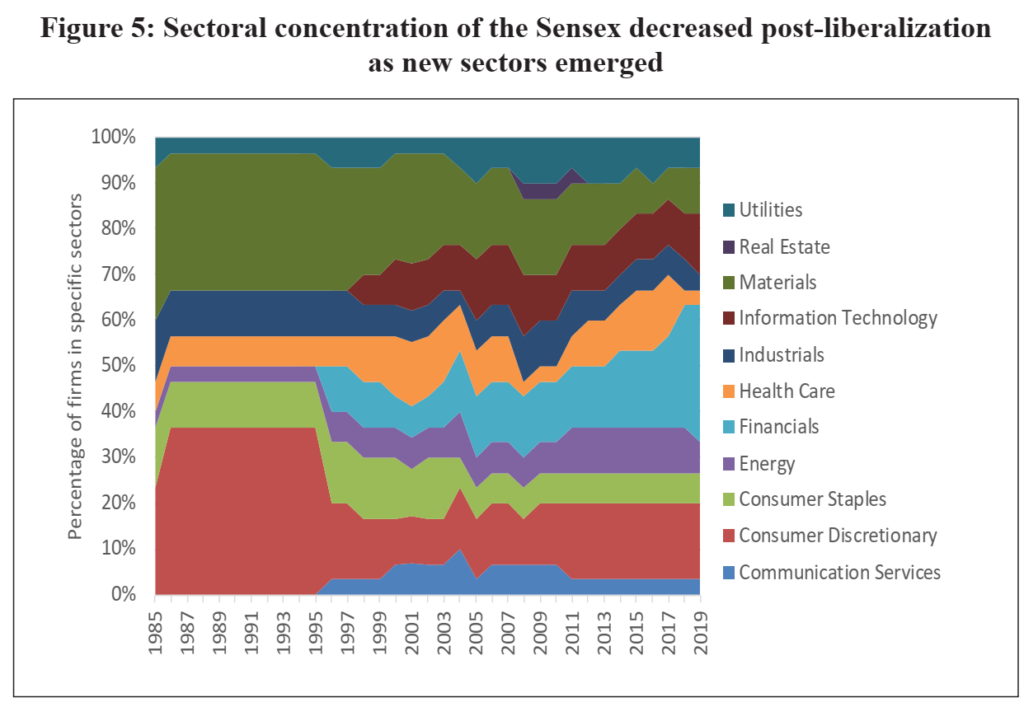
Whether the churn illustrated above was beneficial to the Indian economy?
- The Sensex represents a process of creative destruction rather than spurious dynamism. The firm that displaced the incumbents on the Sensex brought with them new ideas, technologies and processes.
- New sectors like banks and financials entered the index for the first time, eroding the predominance of the manufacturing sector on the index, placing the services sector on the map for the first time, and reflecting the far-reaching changes that the Indian economy was witnessing in the wake of liberalization.
- Financials and information technology, which were virtually non-existent in the Sensex of the early 1990s, are responsible for more than 50 percent of the market share of the Sensex today. With the entry of these new sectors, today’s Sensex is far less concentrated than the Sensex of the 1980s and 1990s and mirrors the far lower sectoral concentration of the Indian economy as a whole.
Sensex being democratic in size and including different sectors
The prime mover of the economy has shifted from agriculture to services. Almost 60 percent of Indian GDP is attributable to the services sector. The number of Sensex firms in manufacturing has reduced while those in services have increased between 1988 and 2019. Today’s Sensex is not only composed of a larger number of sectors but is also far more democratic in terms of the size of companies.
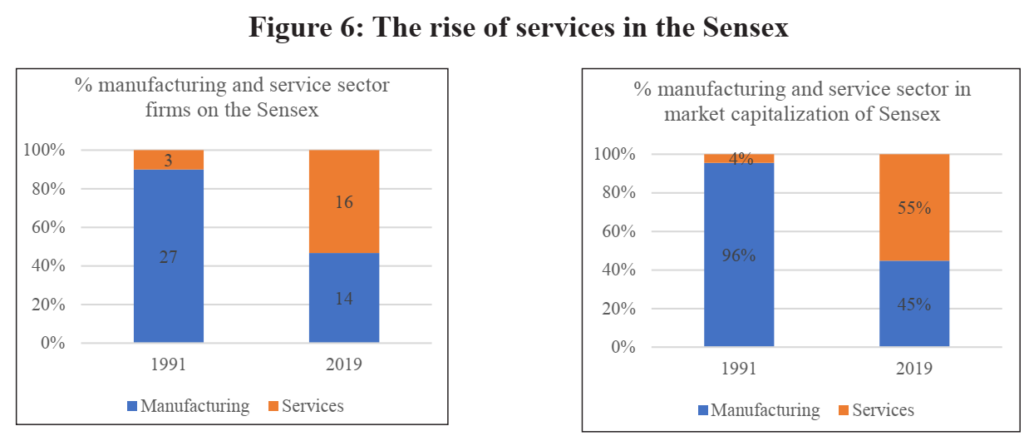
Is the dominance of financials and information technology in the Sensex, a cause of concern?
At first glance, these trends indicate a cause for concern: a potential case of more concentration or a reversal in creative destruction in the economy. However, this is not the case. The reasons are:
- Firstly, the rising share in market capitalization has been accomplished by a rise in the number of companies rather than a rise in the size of incumbents, suggesting greater competition within these sectors.
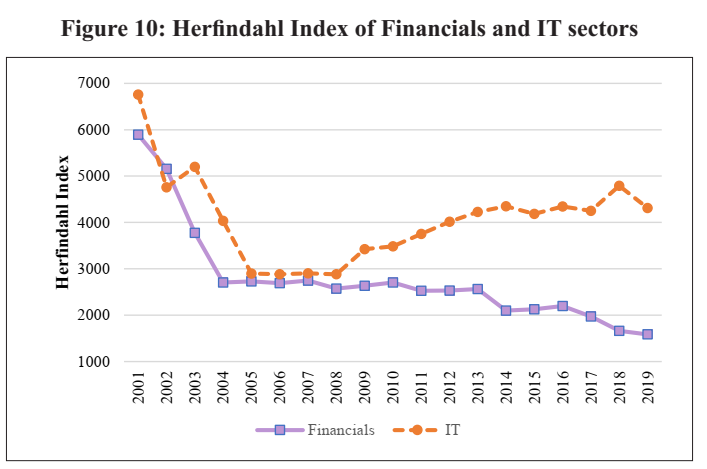
- Secondly, using the Herfindahl Index to analyse the degree of competition within the two sectors reveals an overall decline in concentration in both sectors. However, the IT sector has recently begun to show a slight increasing trend in the Herfindahl Index, indicating that there is room to increase competition in the sector.
Three key insights emerge from the analysis above
- First, we can expect today’s dominant firms to remain dominant for only one-fifth of the time that their liberalization counterparts did.
- Second, sectors once considered mainstays of the Indian economy are being displaced by new sectors bringing with them new technologies and products. The competitive advantage of entrenched firms is being rapidly challenged by new, smaller and more agile firms; every five years, roughly one in three firms in the Indian economy can expect to be challenged in a massive way by the forces of creative destruction.
- Finally, the difference between the sizes of the largest and smallest firms is rapidly shrinking, and consequently, monopoly power in the economy is declining and making way for more competitive markets. Consumers benefit from an increased variety of goods and services, lower prices and incessant improvement in the quality of existing products.
Difference between pro-business and pro-crony policy

Pro-Crony and Wealth Destruction
Pro-crony policies, in contrast to pro-business ones, erode wealth in the economy as cronyism fosters inefficiencies by inhibiting the process of creative destruction.
- Prior to 2010, if the firm’s promoters had “connections”( firms that may benefit from pro-crony policies), it clearly paid a firm and its shareholders.
- “Connected” firms outperformed the broad index of the stock market by 7 percentage points a year on average till 2010. This pre-2010 outperformance of “connected” firms indicates the possible extent of rents extracted by these firms at society’s expense.
- In contrast, the significant post-2010 under performance – following the release of the CAG report – illustrates the fact that such “connected” firms were likely to have been inefficient ones
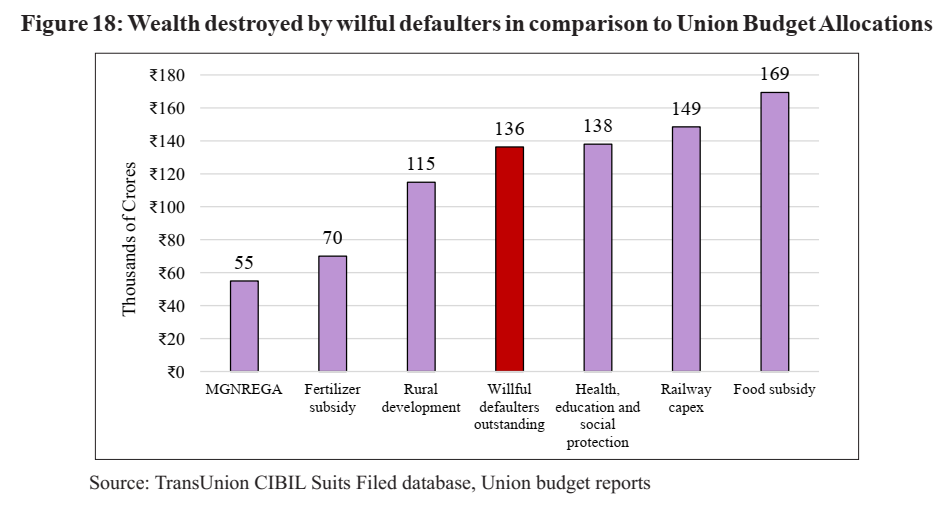
Pro-crony, when compared to pro-business, policies can create various indirect costs as well.
- When opportunities for crony rent-seeking exist, firms shift their focus away from growth through competition and innovation towards building political relationships, thus undermining the economy’s capacity for wealth creation.
- Further, the rents sought by cronies are paid for by genuine businesses and citizens who are not receiving any preferential treatment.
- Such a transfer of wealth exacerbates income inequality in the economy, as crony firms leverage their connections to extract a larger share of existing wealth instead of expanding the available wealth.
Discretionary Allocation of Natural Resources Vis-À-Vis Allocation via Auctions
India has the fifth-largest coal reserves in the world behind the USA, Russia, China, and Australia. Coal is the most important indigenous source of energy for India; it meets more than half of India’s energy requirements.
The Economic Survey explains in this chapter that how political connection used in gaining the allocation of resources affects the economy. It gives the example of coal mines allocation.
- Prior to 1993, no specific criteria for the allocation of captive mines existed. Amendments introduced to the Coal Mines (Nationalization) Act 1973 in June 1993 allowed private companies to carry out coal mining for captive use.
- In July 1992, a screening committee was set up under the chairmanship of the Secretary of Coal to consider applications made by various companies interested in captive mining and to allocate coal blocks for development.
- In August 2012, the CAG report on coal block allocations examined the effectiveness of the processes adopted in the allocation of coal blocks. On 24 September 2014, the Supreme Court of India cancelled 214 of the 218 allocations made by the Government of India over a span of 15 years.
- The Coal Mines (Special Provisions) Bill, 2014, and its subsequent rules were passed in December 2014, and the Coal Mines (Special Provisions) Act, 2015, was included in the Indian mining legislative framework. The Act ensured that any future allocation of coal blocks would solely be through competitive auctions.
Riskless Returns: The Case of Wilful Default
- Although the primary tenet of any investment is that high expected rewards come with high risk, many Indian firms have found a peculiar way to reap rewards without commensurate risk.
- Many firms enjoy profits in good times but often rely on the state or their financiers to bail them out in bad times. A particularly egregious form of such riskless return is the phenomenon of wilful default.
- Wilful default occurs when firms take loans, divert the proceeds out of the firm for the personal benefit of owners, default on loans and declare bankruptcy, thereby expropriating a range of stakeholders – lenders, minority shareholders, employees regulators, and state coffers.
- Every rupee lent to a wilful defaulter constitutes an erosion of wealth. Money lent to a genuine business creates assets, which generate profit and employment.
- On the other hand, money lent to a firm that has no intention of investing the proceeds in ex-ante profitable projects is money wasted.
- Besides making cronies rich, it contributes nothing to the economy.
- As of 2018, wilful defaulters owed their respective lenders nearly 1.4 lakh crores.
Distinguishing characteristics of wilful defaulters in India
- Wilful defaulters tend to be more opaque than both non-defaulters and firms that default out of genuine distress.
- Promoters at the helm of wilfully defaulting firms pledge, on average, almost 50 percent of their shareholding to lenders. In contrast, the corresponding figures for distress defaulters and non-defaulters are 30 percent and 11 percent respectively.
- Wilful defaulters make large loans to related parties. The outstanding balance of loans given to related parties for distress defaulters and non-defaulters is negative, meaning that the average firm in the sample is a net recipient of loans from related parties. Wilful defaulters, on the other hand, are net givers of loans. Peculiarly, they are net recipients of external loans and defaulters on these loans at the same time that they are net givers of loans to their related parties.
This is consistent with a theory of issuing debt only to siphon the proceeds out of the firm for the personal benefit of owners and their cronies.
Conclusion
While pro-business policies increase competition, correct market failures, or enforce business accountability, pro-crony policies hurt markets. Such policies may promote narrow business interests and may hurt social welfare because what crony businesses may want may be at odds with the same. For example, crony businesses may lobby the government to limit competition in their industry, restrict imports of competing goods or reduce regulatory oversight. These initiatives enhance the lobbying group’s income but undermine markets and reduce aggregate welfare. Thus, a pro-crony policy can inadvertently end up being hurtful to businesses in general.
MCQs
- Which of the following is/are the characteristics of the “Wilful Defaulter”:
1- It is a firm that has defaulted in meeting its repayment obligations even though it can honour these obligations.
2- It uses the funds for purposes other than what is sanctioned by the lender.
Select the correct answer using the codes given below.
A. 1 only
B. 2 only
C. Both 1 and 2
D. Neither 1 nor 2
Ans. (C) The Reserve Bank of India (RBI) defines wilful defaulter as a firm that has defaulted in meeting its repayment obligations even though it can honour these obligations.
A firm could also be branded a wilful defaulter if it uses the funds for purposes other than what is sanctioned by the lender, siphons the money out to related parties or removes the assets used to secure the loan.
Wilful default occurs when firms take loans, divert the proceeds out of the firm for the personal benefit of owners, default on loans and declare bankruptcy, thereby expropriating a range of stakeholders – lenders, minority shareholders, employees, regulators and state coffers. - In the context of the economy, the term “Dutch Disease” is seen in the news sometimes. Consider the following statements about it:
1- It describes an economic phenomenon where the rapid development of one sector of the economy (particularly natural resources) precipitates a decline in other sectors.
2- It is also often characterized by a substantial appreciation of the domestic currency.
Which of the above statements is/are correct?
A. 1 only
B. 2 only
C. Both 1 and 2
D. Neither 1 nor 2
Ans. (C) Learning Zone: Dutch disease is a concept that describes an economic phenomenon where the rapid development of one sector of the economy (particularly natural resources) precipitates a decline in other sectors.
It is also often characterized by a substantial appreciation of the domestic currency. Dutch disease is a paradoxical situation where good news for one sector of the economy, such as the discovery of natural resources, results in a negative impact on the country’s overall economy. - With reference to the importance of coal in the Indian economy, consider the following statements:
1- India has the fifth-largest coal reserves in the world.
2- Coal meets more than half of India’s energy requirements.
Which of the above statements is/are correct?
A. 1 only
B. 2 only
C. Both 1 and 2
D. Neither 1 nor 2
Ans. (C) India has the fifth-largest coal reserves in the world behind the USA, Russia, China, and Australia. Coal is the most important indigenous source of energy for India; it meets more than half of India’s energy requirements. - Which of the following is/are the characteristics of the “Pro-Crony” Economy?
1- Some incumbent firms may receive preferential treatment.
2- Resource allocation in the economy may not be efficient.
3- Citizens’ welfare may not be maximized.
Select the correct answer using the codes given below.
A. 1 and 2 only
B. 1 only
C. 3 only
D. 1, 2, and 3
Ans. (D) Under ‘Cronyism’, the government rigs the market for the benefit of government officials’ cronies. This takes various forms. Governments sometimes grant monopolies to one firm or limit the number of firms that can compete. Governments sometimes use quotas or tariffs to limit imports to protect the wealth and jobs of domestic producers who compete with those imports. Governments sometimes subsidize favoured producers or may use antitrust laws to prevent companies from cutting prices so that other, less-efficient companies can prosper.
Characteristics of Pro-Crony policy are as follows-
● Some incumbent firms may receive preferential treatment.
● Resource allocation in the economy may not be efficient.
● Citizens’ welfare may not be maximized
Pro-crony policies, in contrast to pro-business ones, erode wealth in the economy as cronyism fosters inefficiencies by inhibiting the process of creative destruction. - Consider the following statements about the “Herfindahl Index”:
1- It is a measure of the competition among the firms in a particular industry.
2- The higher number of Herfindahl index indicates the scope for competition in the sector.
Which of the above statements is/are correct?
A. 1 only
B. 2 only
C. Both 1 and 2
D. Neither 1 nor 2
Ans. (C) The Herfindahl index (also known as Herfindahl–Hirschman Index) is a measure of the size of firms concerning the industry and an indicator of the amount of competition among them.
Named after economists Orris C. Herfindahl and Albert O. Hirschman, it is an economic concept widely applied in competition law, antitrust and also technology management. It is defined as the sum of the squares of the market shares of the firms within the industry (sometimes limited to the 50 largest firms), where the market shares are expressed as fractions.
If any sector has recently begun to show a slight increasing trend in the Herfindahl index then that indicates there is room to increase competition in the sector.



